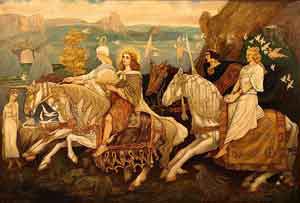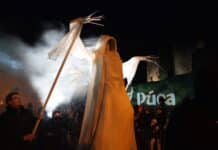AMY VAN CASTEELE looks at how the legends of the Sidhe, the mystical people of fairy mounds, still grip Ireland
Ireland, otherwise known as the Emerald Isle, has been associated with fairies for many hundreds of years, dating all the way back to the time of the Iron Age and beyond, when the country was said to be under the power of the mystical Tuatha De Danann.
A race of supernatural beings which were “like gods and yet not gods”, the Tuatha are essentially thought of as being fairy beings, though some Christians viewed them as fallen angels; historical accounts of them were penned by Christian monks centuries after these otherworldly beings seemingly vanished from Ireland.

They are also mentioned in the Book of Invasions, which recounts how they came to Ireland from 4 mythic cities to the North, bringing with them four objects of power.
Powerful, warlike and steeped in wisdom and magic, these fairy beings defeated the native Fomorians and claimed Ireland for their own until they were, in their turn, defeated by the Milesians, ancestors of the modern-day Irish, around the dawn of the Iron Age.
It is said that, when they were vanquished, they were forced to retreat underground to the Otherworld – and the many “fairy forts”, raths and mounds which are dotted across Ireland are the entrances to their subterranean realm.
Funnily enough, archaeologists have dated many of these mounds as being built during the beginning of the Iron Age – just when the Tuatha were said to have been defeated.
The prevalence of these mounds, and the myths and folklore attached to them, is why the Tuatha are also known as the Sidhe, which translates as people of the mounds, or people of the hills.
Portals to the other realm as well as burial chambers and fairy dwellings, supposedly these mounds are protected by strong magic, blessings and prayers to prevent humans from desecrating or entering their secret underground passageways.
If the magic fails and they are destroyed, curses and misfortune will follow whichever callous mortal was foolish enough to demolish a fairy fort.
Even the trees and bushes which grow around the mounds are sacred; to cut one down is supposedly to risk magical retribution, perhaps even death.
To this day, farmers are reluctant to damage the raths and mounds on their land, and if they do pluck up the courage they can be fined thousands of Euros as penalty for their crass actions.
That was the case two years ago in Kilmurry, County Cork, when a farmer destroyed two fairy forts; he was promptly fined €20,000.
Fairy forts are clearly still considered to be sacred spots; a number of them are even tourist destinations.
Though many people may not openly confess to a belief in fairies and the Otherworld, this desire to protect “fairy dwellings”, and the fear of arousing the wrath of the Sidhe, betrays a deep-rooted faith in their existence.
There are many old stories of people suffering misfortune when they interfered with a fairy mound.
In the 1800s a group of three young men began to dig up one of the fairy forts, hoping to find the gold and jewels which legend tells may be buried inside; no treasure was found and all three were later struck down by tuberculosis. They all died of the disease.
More recent tales also abound of unfortunate farmers and property developers who have suffered as a result of destroying – or attempting to destroy – a fairy mound.
Famously, construction work on the M3 Motorway, which began in 2007, resulted in several unpleasant accidents and was said to have unleashed the “curse of Tara” as the building of the motorway led to the destruction of several fairy forts in the Tara Skryne Valley.
Some of the frightening incidents involved included the then Minister for the Environment’s encounter with an armed gang and later sacking; a falling tree which nearly killed the Chief Health and Safety Officer; and the death of a worker who was trapped at Fairyhouse.
At the same time a number of sizeable wasp nests were discovered dotted across the valley; according to folklore wasps are associated with the wrath of the Earth Mother herself.
Were these grim accidents the result of the anger of “The Gentry”, as the fairy folk are sometimes called? Or were they mere coincidence?
Whatever you choose to believe there can be no denying the fact that Ireland remains firmly tied to its ancient faith in The Fair Folk. This faith is evident in the many fairy-related place names, as well as in the mounds themselves and the reverence with which they are so often treated.
Even if you dismiss tales of the Sidhe or the Tuatha as mere fairy tales and folklore, one thing is certain; belief in these creatures in turn leads to a greater respect for the environment and for the ancient monuments of historic and mythological Ireland.
In an age when so little is sacred, when urban sprawl threatens to desecrate the spectacular countryside of Great Britain, surely this can be no bad thing?







